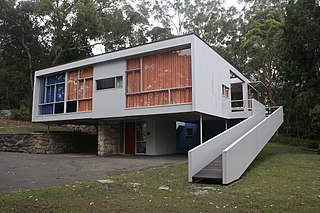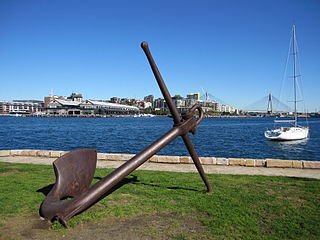
Walter Burley Griffin was an American architect and landscape architect. He is known for designing Canberra, Australia's capital city and the New South Wales towns of Griffith and Leeton. He has been credited with the development of the L-shaped floor plan, the carport and an innovative use of reinforced concrete.

Harry Seidler was an Austrian-born Australian architect who is considered to be one of the leading exponents of Modernism's methodology in Australia and the first architect to fully express the principles of the Bauhaus in Australia.

The Harry and Penelope Seidler House is a heritage-listed modernist house located at 13 Kalang Avenue in the Sydney suburb of Killara in the Ku-ring-gai Council local government area of New South Wales, Australia. It was designed by architects Penelope and Harry Seidler and Harry Seidler & Associates, and built from 1966 to 1967 by Peter Cussel. It was added to the New South Wales State Heritage Register on 20 June 2008.

Architecture of Australia has generally been consistent with architectural trends in the wider Western world, with some special adaptations to compensate for distinctive Australian climatic and cultural factors. Indigenous Australians produced a wide range of structures and places prior to colonisation. Contemporary Indigenous practitioners are active in a broad range of built environment fields. During Australia's early Western history, it was a collection of British colonies in which architectural styles were strongly influenced by British designs. However, the unique climate of Australia necessitated adaptations, and 20th-century trends reflected the increasing influence of American urban designs and a diversification of the cultural tastes and requirements of an increasingly multicultural Australian society.

Rose Seidler House is a heritage-listed former residence and now house museum located at 69-71 Clissold Road in the Sydney suburb of Wahroonga in the Ku-ring-gai Council local government area of New South Wales, Australia. It was designed by Harry Seidler and built from 1948 to 1950 by Bret R. Lake. It is also known as In neighbourhood precinct with Marcus Seidler House and Teplitzky House or Rose House. The property is owned by the NSW Office of Environment and Heritage, an agency of the Government of New South Wales. It was added to the New South Wales State Heritage Register on 2 April 1999.

Australian residential architectural styles have evolved significantly over time, from the early days of structures made from relatively cheap and imported corrugated iron to more sophisticated styles borrowed from other countries, such as the Victorian style from the United Kingdom, the Georgian style from North America and Europe and the Californian bungalow from the United States. A common feature of the Australian home is the use of fencing in front gardens, also common in both the United Kingdom and the United States.

The El Alamein Memorial Fountain is a heritage-listed fountain and war memorial located at Macleay Street in the inner Sydney locale of Kings Cross in the City of Sydney local government area of New South Wales, Australia. It was designed by the Australian architects Robert Woodward and Phill Taranto as employed by architectural firm Woodward and Woodward. The fountain was built from 1959 to 1961. It is also known as El Alamein Fountain, Fitzroy Gardens Group, Kings Cross Fountain and King's Cross Fountain. It was added to the New South Wales State Heritage Register on 14 January 2011. The El Alamein Fountain was commissioned as a memorial to soldiers who died in 1942 during World War II in two battles at El Alamein, Egypt.

Seabrook and Fildes was an Australian architecture practice in Melbourne, Victoria that played a significant role in the introduction of modernist architecture that first occurred in the 1930s. They are most well known for the Dutch modernist inspired Mac.Robertson Girls High School, designed by Norman Seabrook in 1933.
Eva Buhrich (1915–1976) was a German architect and writer who fled Nazi Germany in the 1930s, emigrated to Australia and became a prominent architectural commentator.
Penelope Alice Marjorie Seidler AM is an Australian architect, former member of National Gallery of Australia Council, and current member of the NGA Foundation Board. She is also an accountant and director of the Sydney-based architectural firm Harry Seidler and associates. She was the wife and professional partner of architect Harry Seidler. She was the subject of the 2014 Archibald prize winning portrait by Fiona Lowry.
Duncan House is a heritage-listed residence located at 8 The Barbette, Castlecrag, City of Willoughby, New South Wales, Australia. It was designed by Walter Burley Griffin. It is also known as Duncan House Number 2. It was added to the New South Wales State Heritage Register on 2 April 1999.
Buhrich House II is a heritage-listed residence located at 375 Edinburgh Road, Castlecrag, City of Willoughby, New South Wales, Australia. It was designed by Hugh Buhrich and built during 1972. The property is privately by members of the Buhrich family. It was added to the New South Wales State Heritage Register on 25 May 2001.
The Glass House is a heritage-listed domestic dwelling located at 80 The Bulwark, Castlecrag, City of Willoughby, Sydney, New South Wales, Australia. It was designed by Bill Lucas. It is also known as Glasshouse; Bill Lucas House. It was added to the New South Wales State Heritage Register on 21 October 2016.

The Old Registry Office of the Supreme Court of New South Wales is a heritage-listed courthouse at the corner of Elizabeth Street and St James Road, in the Sydney central business district in the City of Sydney local government area of New South Wales, Australia. It was designed by Government Architect Alexander Dawson and James Barnet and built from 1859 to 1862. It is also known as Sydney Supreme Court House. The property is owned by the Department of Justice, a department of the Government of New South Wales. It was added to the New South Wales State Heritage Register on 2 April 1999.

The MLC Building is a landmark modernist skyscraper in the central business district of North Sydney, on a block bounded by Miller Street, Denison Street and Mount Street. Planned in 1954 and completed in 1957, the complex was designed in the modernist Post-war International style by architects, Bates, Smart & McCutcheon. Its completion marked the appearance of the first high-rise office block in North Sydney and the first use of curtain wall design. Built to provide much-needed office space for the Mutual Life & Citizens Assurance Company Limited, the building continues to be primarily-occupied by its original tenants.

Simpson-Lee House I is a heritage-listed residence located at 23 Roland Avenue, in the Sydney suburb of Wahroonga in the Ku-ring-gai Council local government area of New South Wales, Australia. It was designed by Arthur Baldwinson and built from 1958 to 1962 by George M. Koch. It is also known as Simpson Lee House. It was added to the New South Wales State Heritage Register on 27 November 2009.

The Christ Church Anglican Church is a heritage-listed Anglican church building located at 345-347 Great Western Highway, Springwood, City of Blue Mountains, New South Wales, Australia. It was designed by Sir John Sulman and built from 1888 to 1889. It is also known as Christ Church of England and Springwood. The property is owned by Springwood Anglican Parish. It was added to the New South Wales State Heritage Register on 2 April 1999.

Iloura Reserve is a heritage-listed public reserve on the site of a former timber yard at 10-20 Weston Street, Balmain East, Inner West Council, Sydney New South Wales, Australia. Following the resumption of the timber yard for public space in the 1960s, the present reserve was designed and laid out by landscape architect Bruce Mackenzie and constructed in two stages: stage one in 1970 and stage two in 1981. It is also known as Peacock Point and Illoura. The reserve is owned by the Inner West Council. It was added to the New South Wales State Heritage Register on 29 November 2013.
Torin Building is a heritage-listed former factory and now factory and office space located at 26 Coombes Drive in the western Sydney suburb of Penrith in the City of Penrith local government area of New South Wales, Australia. It was designed by Marcel Breuer and built from 1975 to 1976. It is also known as the Former Torin Corporation Building and Breuer Building. It was added to the New South Wales State Heritage Register on 15 May 2009.

Science House is a heritage-listed commercial building located at 157–169 Gloucester Street and Essex Street, in the inner city Sydney suburb of The Rocks in the City of Sydney local government area of New South Wales, Australia. It was designed by Peddle Thorp & Walker Architects and built in 1930 by John Grant and Sons, Master Builders. It was also known as Sports House from 1978–1991. The building is owned by Denwol, a property group owned and controlled by Phillip Wolanski AM. It was added to the New South Wales State Heritage Register on 10 May 2002.












